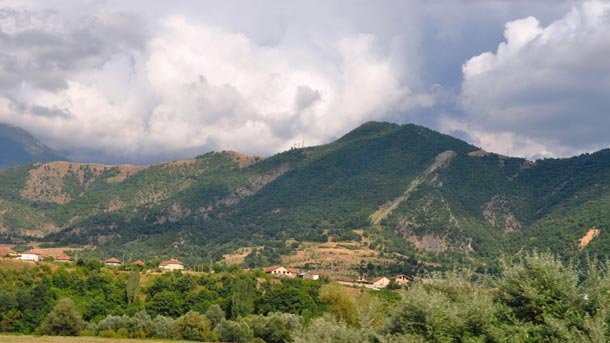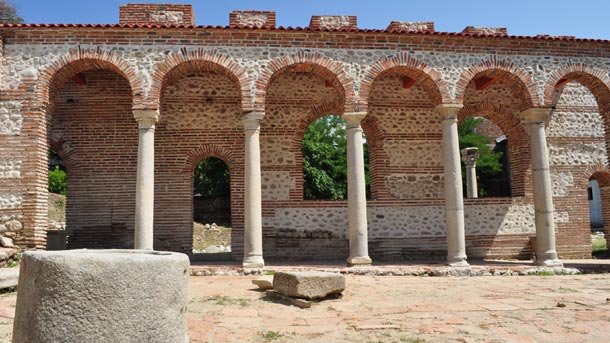
The Bulgarians usually relate the town of Sandanski with the warmth of the South, the Mediterranean flora that is not typical for this country and with the mineral springs at the foot of the Pirin Mountain. The town is also situated only 100 km away from the magnificent Greek beaches. However, there are people that opt for a visit to Sandanski due to its history and the legend of Spartacus.
The bronze monument of the ancient hero at the entrance of the city park has become a symbol of the resort. The biggest neighborhood of the town, the stadium, the local martial arts club, lots of restaurants, hotels, clubs etc. – they are all named after Spartacus. Some parents decided to give the same name to their newly born babies. No wonder that the locals are proud of their celebrity, since historical sources give them that right.
The first written records on the region mention that the valley of the Struma /Strimon/ River was inhabited by the Thracian Maedi tribe. This territory was Roman during the 2nd century BC. Supposedly Spartacus was born somewhere here, along the river’s valley and in this tribe. Ancient Greek historian Plutarch, who lived in the 1st century AD also mentioned that. German expert in Antiquity Prof. Ziegler confirmed that theory too during the 1970s through the translation and interpretation of a lost text, reading that Spartacus had been one of the Maedi tribe. However, we have no certain local sources, confirming his birthplace, says Director of Sandanski’s Museum of History Vladimir Petkov.
It is presumed that Spartacus was captured by the Romans during the invasion of their legions in this part of the Balkans. He was later sold as a slave and taken to the Italian Peninsula. Lentulus Batiatus, owner of one of the biggest schools for gladiators noticed the unusual strength and beauty of the young slave and… we all know the following story. Poets, sculptors, artists, writers and directors have been inspired for centuries by the legend of the leader of one of the greatest uprising of slaves in human history.
Sandanski’s municipal administration and local entrepreneurs have prepared a project, aiming at the popularization of the town’s antique history. The slave market, where Spartacus was supposedly sold will be restored for that purpose. It is situated in the village of Sklave nearby. The name of the village originates from the Latin word sclavus, meaning… a slave. Sandanski’s Deputy Mayor Mladen Timchev gives us more curious details:
“History and artifacts say that a slave market took place in the village of Sklave around the June solstice. The funny thing is that a traditional fair still takes place in Sklave during these days, with farm animals mainly traded. So we will try to recreate the ancient market with some interesting animation and with the support of theatre formations and our consultants – historians and archaeologists.”

© Photo: Veneta Nikolova
The tourist route will also include other spots, related to the ancient times of gladiator fights. Theatres were the most attractive places for people in Antiquity. One can find the very well preserved remains of a magnificent Ancient theatre downtown Sandanski. It is supposed that gladiator’s fights took place there, including even… wild animals. also says that:
“When the Roman Empire conquered the Balkans, gladiator fights became part of the ancient towns’ everyday life", Mr. Petkov goes on to say. "Men started to join gladiator schools and then to take part in these attractions. We want to recreate the ancient fights, to get the guests acquainted with the different types of gladiators and to help them feel the authentic atmosphere of the past.”
The Sandanski Municipality expects that the project will attract more guests in the region. In the meantime Greek tour operators have already included Sklave in their 2013 routes. Tourists will also have the chance to visit other ancient and early Christian landmarks – for instance, the so-called archaeological park, situated in the heart of Sandanski with the remains of a bishop’s basilica from the 5-6 century, early Christian mosaics, murals etc.
English version: Zhivko Stanchev
In winter, the well-known Bulgarian town of Kotel known for its National Revival Period architecture attracts tourists with cultural routes, frosty landscapes and the opportunity to ski in the folds of the Balkan Mountains. About 4 km from the center of..
An exhibition showcasing iconic cultural and natural tourist sites from Bulgaria has been opened in front of the Bulgarian Embassy in Stockholm. "Bulgaria is a country with an impressive history, rich cultural and historical heritage and..
The winter resort of Pamporovo in the Rhodope Mountain is crowded. We are experiencing a strong season and an increase in tourists from Romania, Greece and Serbia. This was told to BTA by Dimitar Gerdzhikov from Pamporovo AD. Gerdzhikov added..
The Ministry of Tourism has launched a large-scale international advertising campaign on National Geographic and 24 Kitchen channels, part of The..
Last summer, Bulgaria's coastal city Burgas and the surrounding resort towns welcomed about 600,000 Bulgarian and foreign tourists , which is 21% more..

+359 2 9336 661
